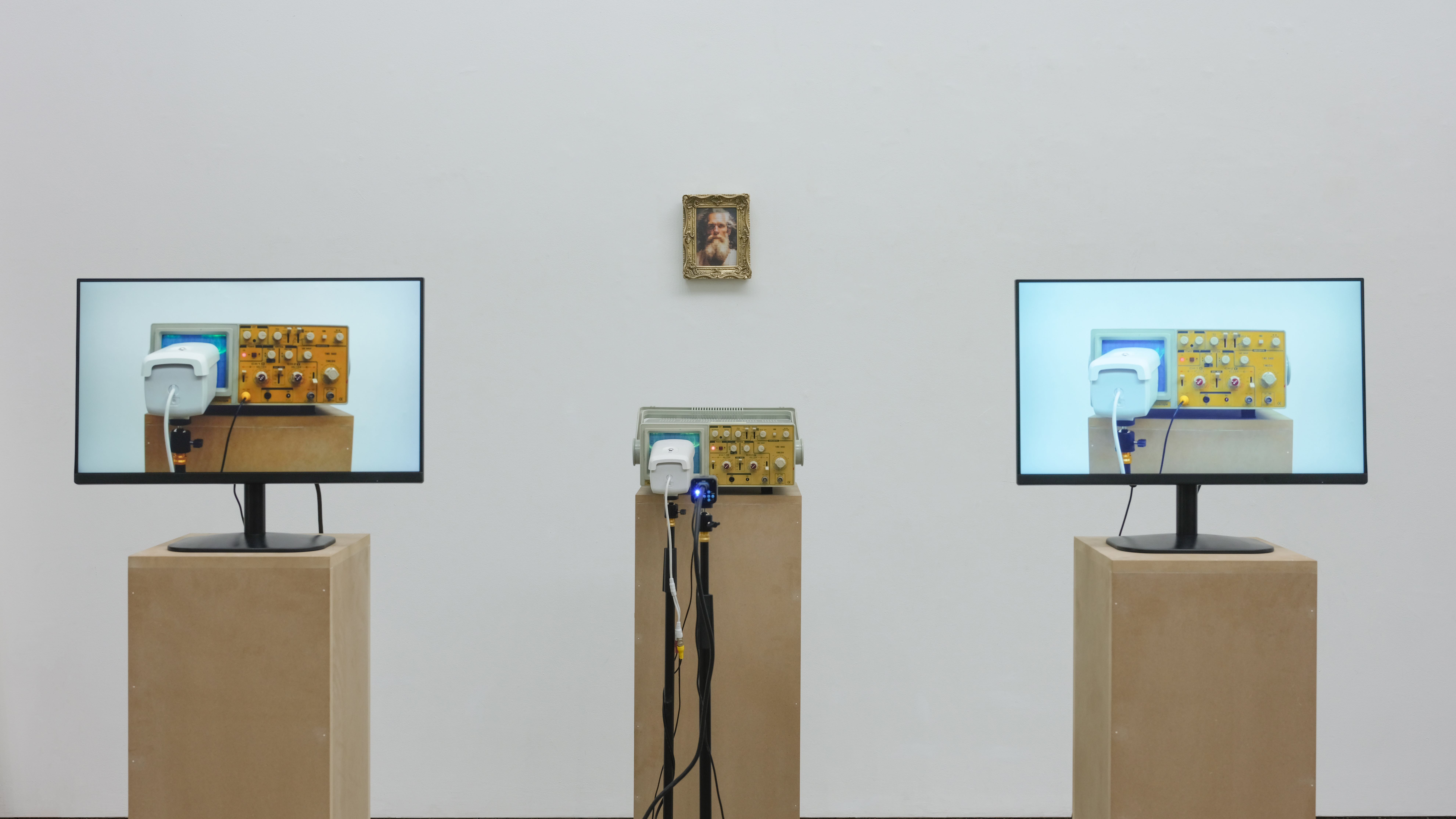Enframing
 Enframing
Enframing2023
Oscilloscope, CCTV camera, live streaming camera, screens, AI-generated God with a Golden frame, plinths, cables
2x2x2m
"Technology is a way of revealing." Heidegger, in his work "The Questions Concerning Technology," presents to us a logic of modern technology called "Enframing." This logic simplifies reality into the logic of means and ends, advocating that everything only has meaning when we use it to obtain what we desire. Indeed, this logic is omnipresent. The influence of technology has gradually permeated every corner of modern and contemporary society. However, assuming that this logic is controlled or dictated by humans would be arbitrary or incorrect. What constitutes the "best" result is not actually determined by humans. Let's consider a simple example: when taking a photograph, we naturally adjust the camera settings to achieve proper exposure. We choose appropriate aperture, shutter speed, and ISO parameters based on the situation to obtain a "satisfactory" or "best" photo. However, this "best" is not for us. In fact, we are choosing the parameters that are "best" for our camera, the photographic device. Technology not only shapes our worldview and behavior, but also molds our way of evaluating the world, determining how we define good and bad.
Technology is an ideology. It permeates every aspect of life. It truly can be like a new God, giving us the ability to achieve specific goals. If we want to communicate with someone far away, we use the telephone. If we want to see stars in the universe, we use a telescope. If we want to capture a moment, we use a camera. Reality is simplified into the logic of means and ends. And we ourselves are increasingly simplified by this logic. When we press the shutter button on a camera, in that instant, we become a means for the camera to obtain a photograph, a function. Does it alienate us? Whether we serve technology or ourselves, in the process of using technology, we inevitably act according to the logic of "Enframing." In this process, humans have already become alienated.
Does technology possess sublimity? What problems does technology bring to humans? These are the questions that Lei attempts to explore through his installation. "Enframing" is the title of this set of installations, directly borrowing terminology from Heidegger's description of the essence of technology. Simply, this installation is a sublime shrine to technology. The core part of the installation is an oscilloscope connected to a CCTV camera. The camera points towards the oscilloscope screen, transmitting the image signal into the oscilloscope, which then converts the image signal into waveforms displayed on the screen, captured again by the camera, and the loop cycle repeats. This process symbolises the self-creation of technology. On both sides of the plinths, there are two screens displaying its images. The left screen shows real-time video of the core part, continuously converted into images by a live camera positioned directly in front. The right screen shows recorded video through a media player. Finally, in the center of the wall, a god generated by Midjourney AI is presented to the audience. The surface of the god is grid-like, symbolising fiction or generation.
What is real? This is a question of authenticity that technology brings to us and one of the most significant issues in today's digital society. It seems that many things on the internet have lost their origins and instead have become copies. How can we determine the authenticity between these copies? Which one is real and which one is fake? Or does truth even exist? Lei attempts to pose this question to the audience through the images displayed on the two screens. Has authenticity dissolved between simulation and the simulation of simulation? Or perhaps both are real, as Jean Baudrillard proposed in "Simulation and Simulacrum. "
Is humanity alienated by technology? This is another question. As previously explained, "Whether we serve technology or ourselves, in the process of using technology, we inevitably act according to the logic of 'Enframing.' In this process, humans have already become alienated." Perhaps this is true. Nietzsche said, "God is dead." After that, the sublime that existed in nature disappeared. People turned their reverence for the sublime towards the veneration of technology. Technology has been rapidly advancing and continues to do so to this day. The era of AI is also approaching, forcing us to rethink the impact of technology on humanity. It indeed grants us certain abilities like a god to achieve specific goals. However, in this process, humans transition from being the ends to becoming a means to achieve those ends. Humans are encompassed by the logic of technology or, more precisely, the logic of the programme apparatus used, becoming functional components of the apparatus. This process is hidden and even difficult to control. Through the use of certain technology and its programme, humans unavoidably become programmatically transformed into functional parts.
The return of human subjectivity is necessary. After all, we live in reality, not within the logic of technology. We are born from nature, exist within nature, and eventually must return to nature. Technological progress may only imply progress in technology itself, and it cannot fully represent human progress. Technology cannot become a new god, fulfilling all desires. Humans must become their own god, existing in reality and in nature, rather than immersing themselves in "Enframing," being both revealed and deceived.
References
Baudrillard, J. (1983). Simulation and Simulacrum.
Flusser, V. (2011). Into the Universe of Technical Images. Minneapolis: University Of Minnesota Press.
Flusser, V. (2013). Towards a Philosophy of Photography. London: Reaktion Books.
Gertz, N. (2019). Nihilism. The MIT Press.
Heidegger, M. (1977). The Question Concerning Technology and Other Essays.